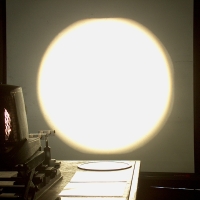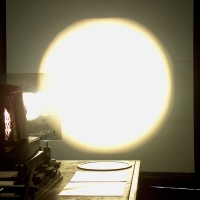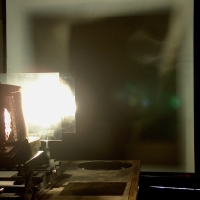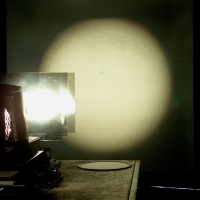Crossed polarizers with third polarizer
(Courtesy of Chuck Reese)
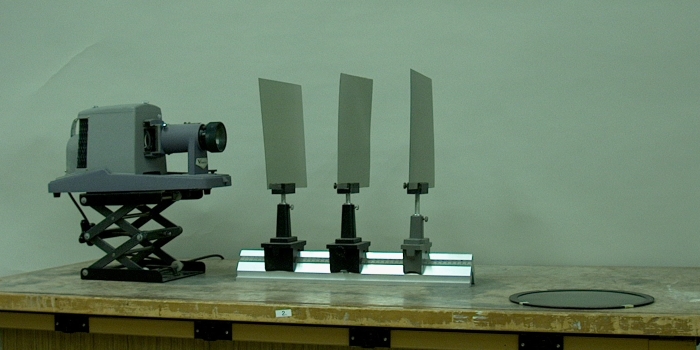
This demonstration shows what happens when one passes light through two polarizers whose “easy axes” are oriented at 90 degrees to each other, and then the interesting thing that occurs when a polarizer whose easy axis is 45 degrees to those of the other two is inserted between them. In the photograph above, the middle polaroid sheet is cut so that its easy axis is 45 degrees to its edges. This enhances the fun and mystery of the demonstration. You can also use the round sheet of polaroid shown at the bottom right corner of the photograph.
The projector illuminates a circular area on a screen, as shown here:
The light from the projector is (of course) randomly polarized.
A single polarizer placed in front of the projector allows only the component of the light’s electric vector that is parallel to its easy axis to pass through. Light whose electric vector is parallel to the polarizer’s easy axis passes through unattenuated. Light whose electric vector is perpendicular to the easy axis cannot pass through at all. Light whose electric vector points in any other direction passes through according to the magnitude of the component that is parallel to the easy axis. The polarizer thus blocks half the incident light, and the transmitted light is polarized in the direction of the easy axis of the polarizer. We observe a bright disc, half as intense as the original one.
A second polarizer placed in front of the first one, with its easy axis perpendicular to that of the first polarizer and thus also perpendicular to the electric vector of the emerging light, blocks all of this light, and none of the light from the projector reaches the screen.
When a third polarizer is placed between the other two with its easy axis at 45 degrees to theirs, a remarkable thing happens. Some of the light that was blocked now gets through to the screen. The electric vector of the light coming from the first polarizer has a component that is parallel to the easy axis of the middle polarizer, so some of the light can pass through. The emerging light is now polarized at 45 degrees to its original direction and also to the easy axis of the next polarizer. The electric vector thus has a component that is parallel to this polarizer’s easy axis, and again some of it can pass through, illuminating the circular area on the screen.
With all three polarizers in place as described and shown here, at each polarizer half the incident light is transmitted, so one-eighth of the light from the projector reaches the screen.
You can show that the easy axis of the middle polarizer is oriented 45 degrees to those of the other two by removing either end polarizer and then rotating the middle one by 45 degrees (in the proper direction, of course). The light will again be totally blocked.
